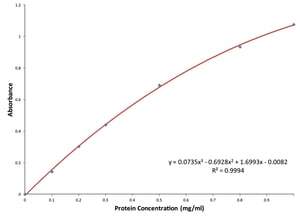 Protein assays are one of the most widely used scientific methods, particularly in life sciences. An assay is an efficient spectroscopic procedure that analyzes the concentration of protein in a solution, also referred to as protein concentration quantitation. Being able to measure this concentration is an integral part of any laboratory workflow involving protein extraction, purification, labeling, or analysis. It is necessary for an array of research, including processing protein samples for isolation, separation, and analysis by chromatographic, electrophoretic, and immunochemical techniques. There are different types of assays and each can be useful for different applications, but many assays work in similar ways and utilize standards.
Protein assays are one of the most widely used scientific methods, particularly in life sciences. An assay is an efficient spectroscopic procedure that analyzes the concentration of protein in a solution, also referred to as protein concentration quantitation. Being able to measure this concentration is an integral part of any laboratory workflow involving protein extraction, purification, labeling, or analysis. It is necessary for an array of research, including processing protein samples for isolation, separation, and analysis by chromatographic, electrophoretic, and immunochemical techniques. There are different types of assays and each can be useful for different applications, but many assays work in similar ways and utilize standards.
Protein Standards & Creating a Standard Curve
Protein assays often use standards to determine the quantity of other proteins, by comparing an unknown quantity of protein to known amounts of the protein standard being used. The protein standard is measured, and its absorbance and concentration are plotted on a graph to create the standard curve. This curve is then used to determine the concentration of the unknown protein.
The Bovine Serum Albumin Standard
The ideal protein standard for protein quantification measurements is a purified sample of the protein you’ll be assaying in your unknown samples. However, that may not always be an option. If a purified sample is unavailable, or is too costly, then you’ll need an inexpensive and readily available alternative – enter bovine serum albumin.
Bovine serum albumin (BSA) is a globular protein that is often used as a protein concentration standard in lab experiments as well as in numerous other biochemical applications. Derived from cows, BSA is extracted from cow blood using one of three different purification methods: cold-organic solvent fractionation, heat shock, and ion exchange chromatography.
It is very useful in different biochemical and life science applications because of its lack of effect in many different biochemical reactions as it does not affect other enzymes that do not need it for stabilization. Another useful aspect of bovine serum is that it is small and can be easily stored. It is stable at room temperature for up to three weeks. In a solution, bovine serum should be stored between 2 and 8 degrees Celsius (35.6 to 46.4 degrees Fahrenheit).
The bovine protein standard is the preferred standard in protein assays because in addition to its ability to increase signal in assays, bovine serum is affordable and easily mass-producible. Since cow blood is a widely available byproduct of the cattle industry, highly pure samples of bovine serum albumin are very accessible at a low cost. It has been prevalent in the use of protein assays since the Bradford Protein Assay was first introduced in 1976.
Finally, BSA offers features like sensitivity, compatibility with common substances in samples (i.e., detergents, etc.), standard curve linearity, and protein-protein variation for reliable, consistent results.
Rely on G-Biosciences for All Your Protein Assay Needs
At G-Biosciences, we offer a selection of protein estimation assays to meet a wide array of applications. Browse through our products and then contact us with any questions or to place an order.






